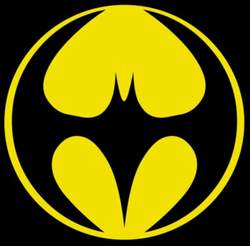CVM
October 1993
Issue 86
When the Bat Breaks…The Knight Will Fall
By Neil Hansen
“…and down will come Batman, costume and all…”
Two new additions to the Batman mythos have turned the caped crusader’s world upside down. One, a villain named Bane, has broken Batman’s back in a quest to ultimately humiliate the spirit of Batman; causing the second, a hero called Azrael, to take over the role that millionaire Bruce Wayne created to fight the forces of evil.
Holy setbacks Gotham City! Will Batman be able to get out of this, or is this the beginning of the end? Readers have already seen Superman killed fighting Doomsday; the world doesn’t seem to be safe for superheroes anymore. Why?
In actuality, the DC creators wanted to explore what it would be like if someone else became the Batman. “To get a different Batman,” said Doug Moench, writer of the Batman comic, “obviously, the original Batman had to step down for a time and a new one had to take his place. Of course, the Batman costume, which has been a classic for so long, also needed a new look. What kind of twist could be done on that? What would the classic design look like if it were altered for the nineties?”
The Beginning of the Break
The genesis of the story called, ‘Knightfall,’ where the old Batman was forced to step down, and the new Batman took over, started two and a half years ago.
“I was having lunch with Peter Milligan, and at the time he was writing Detective Comics,” said Batman group editor Dennis O’Neil, “and we were just talking over story possibilities. He mentioned that it would be a good idea to put someone else in the Batman suit for a while. Peter left meetings,” revealed O’Neil. “I had about four or five of them. We decided that we needed a new villain for this. The only villain that was even close was maybe the Joker; but he’d been used a lot. And even then, he was not emotionally right for this storyline, the way it was developing.”
“The Joker is much more of a psychological villain, “ said Moench, “than a physical villain, and we wanted a physical villain. Bruce Wayne had to be physically unable to continue as Batman to bring about a new Batman.”
The Bane of Batman’s Existence
Bane was created as the instrument of batman’s downfall in a one-shot called Batman: Vengeance of Bane, written by Chuck Dixon and drawn by Graham Nolan and Ed Barreto.
“I don’t remember who exactly said what, said O’Neil, “but most of the credit would go to Chuck Dixon, because he actually wrote the story and filled in the blanks; and without all of those blanks being filled in, you don’t have a very good character.”
Bane was connected with the ‘Venom’ storyline created in Legends of the Dark Knight #16-20, written by O’Neil himself. “I had created him for a completely different story,” O’Neil remembered. “When I wrote that story for Archie Goodwin (Legends of the Dark Knight editor), I certainly didn’t think it would have any ‘life’ beyond those five issues, but that was the one piece that was just serendipity.”
O’Neil’s experience with Batman first started as a writer. He was instrumental in first bringing the character back to his grim roots in 1970 (Detective Comics #395) with artist Neal Adams, following the demise of the popular but campy Batman television series of the 1960’s. Through this foundation, subsequent writers like Frank Miller built on this base, amplifying the grimness that O’Neil originally instituted. Moench, who wrote Batman from 1982 to 1987 had to play catch-up when he returned to the title using Miller’s increased grit and appreciated the fact that O’Neil wanted to go the same way.
“It does feel a little odd,” said Moench, “but I think I’m up to speed now, and I have been since ‘Knightfall’ began. It was strange getting back into it because I no longer read the book after I stopped writing it, so I had to read all of the back issues. One of the good things about it was that, after I left, Batman had been done in the way that I wanted to do it – and did do it to a certain extent, but not as much as I wanted to. At the time, I guess they weren’t ready for a dark, gritty Dark Knight kind of thing which Frank Miller’s book (Batman: The Dark Knight Returns) convinced them that was the way to go. So, before Miller did it, that was the way that I had wanted to go. The editor, Len Wein, kept saying, ‘No, no no! It’s perfect like this!’ and I kept saying, ‘I don’t think you quite know what I mean.’ O’Neil’s critical slant is closer to what I’d wanted to do all along.
The Avenging Angel
The character of Azrael taking over as Batman will push the grit to the limit. In creating Azrael, O’Neil said, “Again, we’d decided that we needed someone fresh.”
For instance, Nightwing, the first Robin and leader of the Titans, was given the thumbs down for the role. However, O’Neil had a bit of a struggle in creating the new character.
“I first looked at animals,” said O’Neil, “trying to think of what’s the natural enemy of the bat. I did some research – which is something writers get to do and pretend that they’re working – and found that the only natural enemies that bats have are men. That seemed to be a dead end, so from there we began to look at mythology. I don’t know how I stumbled onto Azrael, who was an angel of vengeance in two different mythologies, but once we had that – the idea of an angel of vengeance – the rest of it kind of fell into place.”
Azrael, like Bane, didn’t originate in the regular Batman continuity of titles, but began in a four-issue mini-eries called Batman: Sword of Azrael, written by O’Neil and drawn by Joe Quesada and Kevin Nowlan (Quesada, who designed Azrael, is also designing the new Batman costume).
“There was no way to bring them onstage in the current continuity,” O’Neil pointed out, “without bringing everything to a screeching hault, and we didn’t want to telegraph our intentions that far ahead. I’m not sure that the way we did it was the right way, but there was no other way, those two books came out after there had been an awful lot of Batman out, the second movie – so they didn’t get as much attention as they probably would have, even if they weren’t going to be important to later continuity.”
Unfortunately, sales on the Azrael and bane titles weren’t as high as O’Neil thought they’d be. “We were a little disappointed,” O’Neil said, “at the reception of both, because we felt that they deserved better. On the other hand, we couldn’t put a blurb on the cover that said, “This is going to be rally important, dear reader, buy this book!”
However, initial disappointments on the two books turned into big money for comic book dealers.
“I’ve seen Batman: Sword of Azrael #1 go for as much as $25,” O’Neil said. “If I had to do it again, maybe we could have found a way to bring Bane on stage. I work with consummate craftsman, and I will stipulate that even if you never saw those books and will never see them, there’s plenty of information in the stories themselves. You have everything you need to know about those guys if you read Batman and Detective Comics. That’s one of my criteria for doing comics. I don’t think it’s fair to the reader to force them to go outside of what they’ve just bought in order for them to understand what they’ve just read.”
Building Batman
Before Knightfall, there had been complains in fandom that the Batman titles lacked continuity, but O’Neil claimed it’s always been there.
“It just hasn’t been the kind of continuity that Mike Carlin does in Superman, said O’Neil, “where one story ends and the next book picks up ten seconds later. There’s a lot of reasons for that, one of which is that I keep wanting to put emphasis on the story with continuity as a part of that; so I insist that stories have a beginning, a middle, and an end, and that THAT be finite. A writer is really going to have to work to convince me that he is going to need more than three issues to tell a story, so we do that, but I think of it as a mosaic. At the end of the year, all of the features fit into one big picture. We don’t ever contradict unless we screw up, which is a distinct possibility, albeit a distant one. I was being facetious of course. We make mistakes all the time. But, if Tim Drake’s father is kidnapped in one book, he stays kidnapped in the next book; and we can generally figure out that these three issues took about three days of Batman’s life, and that’s this week. The next story takes about two days, so that winds up the week. I’ve got on my computer an outline for the next year,” O’Neil continued, “which never gets more detailed than who the villain is, and if the villain doesn’t exist, it says, ‘new villain,’ which when we’re dealing with something like Knightquest or Knightfall, then there are other things. Where is Jack Drake’s health at a given time? Has Bruce recovered at al by whatever issue it is we’re dealing with? We can maintain that continuity that we spoke of earlier. I’m not going to say it fits seamlessly, but pretty close to it, so at the end of the year you can make sense…assuming that these guys lead very busy lives! I would say that we have continuity working through the strengths of my creative people.”
With Knightfall, and later, the Knightquest storyline demand the other kind of continuity,” said O’Neil, “stillnot as tightly as Mike does it, but a lot more. Even having said that, we ry to keep the story self-contained enough, that if for some reason Batman isn’t available to you, but Detective Comics is, you’ll get enough of the backstory and surrounding information in Detective Comics to understand what is going on here and now.”
However, fandom has noticed similarities between the physical powers of Bane against Batman and the physical powers of Doomsday against Superman. According to O’Neil, this is just confidence.
“If I had known that Mike was going to do his storyline this year,” O’Neil commented, “I would have considered delaying mine. We were both working independently. There was no reason for me to check what he was doing and vice versa. By the time that we figured out that we were both working on major continuity-altering storylines, it was too late to do anything about it. I read Superman as it comes out. I don’t really read other editors’ stuff except as a reader, but I want to enjoy it. Therefore, I don’t look at scripts or artwork ahead of time. Again, if Batman or Robin makes an appearance, I have to look at it, and complain if necessary.”
The Changing of the Guard
Knightfall reaches its penultimate chapter in Batman #500. Among the creative changes that occur are the changing of artistic guards from Jim Aparo to Mike Manley. Aparo moves to Green Arrow after a long run on Batman related comics.
“I left Darkhawk (for Marvel Comics) with #25,” said Manley, “and I was lining up to do some special projects stuff, and Brett Blevins, who’s a really good friend of mine, left his contract at Marvel to look around and see stuff. He went over to see Archie Goodwin (Editor of Legends of the Dark Knight), who we both know at DC, and Archie gave him some work. Bret was saying, ‘You should go see Archie.’ He gave me Legends of the Dark Knight Annual, and a couple people were in the office – Neal Pozner, Mike Carlin – and they asked me if I would be interested in doing some stuff.”
“Then one night,” continued Manley, “at 7:30, Denny O’Neil called me up and asked if I wanted to do Batman. I thought about it for about 30 seconds and said ‘Yeah!’ I had no idea about Batman #500. I hadn’t read Batman in years. His first artwork is chapter 1 of Knightquest: The Crusade,” which focuses on the adventures of the new Batman.”
“I was sort of coming in at the end,” Manley said, “the beginning and the middle because it’s the end of the first part of the storyline they had come up with. I was the new kid on the block. It’s in the middle of the storyline, and it’s at the beginning of the whole big new thing with Batman. Maybe in a way it’s a good thing I haven’t read Batman comics in years, because I’m trying to come at it from a fresh perspective. It’s enjoyable, and I feel I have a lot of freedom. My preconceptions of the character are basically the stuff Neal Adams did when I read as a kid, and the stuff that Frank Miller did himself, and with David Mazzucelli. That’s the stuff I have in my head. It’d be like, if I did the Fantastic Four. I’d think about what Jack Kirby did. I think all creative people do that when they come on. If you were going to do Spiderman, maybe you’d go back and reread the old Steve Ditko and John Romita issues. Maybe for a young guy, it would be Todd McFarlane.”
Still, Manley has admiration for his predecessors.
“I didn’t sit down [when I was hired],” Manley explained, “and think I was following in Jim Aparo’s footsteps. I feel that if it’ a new character, it’ll be different from what Aparo did. I fondly remember the Aparo stuff from when I was collecting the Neal Adams stuff too. I used to confuse his stuff with Neal Adams stuff when I was a kid. He was one of the best guys in the field. He had a great flair for storytelling. I think to some extent, Neal was a better draftsman, coming from the old strips, but Aparo had a lot of dynamic storytelling to his stuff. He’d chop up panels. He was very good at layouts and treating the whole page as a unit.”
“One of the things that I’m trying to do with Batman,” continued Manley, “is bring up the elements of Gotham City and work very hard on the backgrounds. I’ve really cut down on my workload, and I am just working on Batman, not two, three or four projects at the same time.”
“Knightquest: The Crusade will be seen in both Batman and Detective Comics, but what will happen to Bruce Wayne?”
“Denny will take Bruce off in Knightquest: The Search,” said Moench, “and Justice League Task Force, for a three-part story in which Bruce Wayne is trying to solve the mystery of Dr. Sondra Kinsolving and the adduction of Robin’s father.”
“We thought we’d have to logically deal with Superman,” said O’Neil, “so a scene has been written by one of Mike’s guys. We’ll have to deal logically with Nightwing, so that will pop up here and there. We’re dealing with Green Arrow in Justice League Task Force. Our version of Batman is that he is not a very public guy. I don’t think there are a dozen people in Gotham City who have decent photographs of him, and he certainly doesn’t hang around talking to crowds. What the world knows is that he’s changed clothes. A few people in Gotham City – Gordon, Bullock, and Sarah Essen – will react to his personality change. Gordon will be shocked by it, and wonder if he’s gone over the line. Bullock will applaud it like he’s finally figured what to do with the lowlife scum: beat them senseless.”
What Makes A Hero?
“A lot of heroes in movies,” continued O’Neil, “and in other comics, commit whole slaughter pretty casually. That’s another idea that we’re playing with in this series.”
O’Neil to use Bruce Wayne and Azrael to explore different aspects of the same theme. “We decided to not just let Bruce be an invalid,” said O’Neil, “but to tell a story of a different type of heroism. In real life, I have not a great deal of admiration for somebody who charges a machine gun nest because that’s adrenaline, but someone who is in great pain, gets up and makes their life work despite that: that’s a real hero. The story will start in Justice League Task Force #5 and 6, then Shadow of the Bat #21-23 – that’ll be written by Alan Grant and done by the regular shadow team – and I will finish it up in a three-parter in Legends of the Dark Knight, again emphasizing that each of these will be self-contained stories in which a problem will be solved. I would like to believe that anyone who reads just one of these stories will be perfectly satisfied and feel they’ve gotten their money’s worth. If you read all three of them, you get the big picture and find out all the details. “A model for this sort of thing,” continued O’Neil, “is a Dashiell Hammett book called The Dain Curse, which is made up of three novellas, and they were each published separately. Nobody ever knew that they were all part of a large novel, so therefore, everybody who read them – they were serialized in Black Mask (a pulp magazine) – got their money’s worth. Then Hammett pulled them all together with very little rewriting into one novel, and you’d say, ‘Oh yeah, man! Now I really see what this is about!’ That’s what we’re trying to do with Knightquest: The Search. We will have failed if we don’t provide lots of action, melodrama, and larger than life characters; but underneath that, [we’re dealing with] heroism. Is it the very violent action that Azrael does? Is it the thing that Bruce Wayne is doing?”
While O’Neil couldn’t divulge the length of Knightquest, or the permanence of the changes, he did disclose, “We’re going to build it to a dramatic conclusion. We’re exploring the character of Azrael. To some degree, we are waiting for feedback. We’re seeing how readers feel about it. We’re seeing how readers feel about it, and how we feel about it.”
Anniversary Shakeups
Between the publicity of the death and resurrection of Superman in Superman #75 and Adventures of Superman #500, and the current goings on with the Caped Crusader with the new armored Batman debuting in Batman #500, violent occurrences and radical changes seem to be the new milieu for DC superheroes anniversaries.
“Mike Carlin and I arrived at our ideas completely separately,” said O’Neil, “without so much as ten seconds consultation, but I can pretty much figure out why we did it. We both have the same problem to solve, and that is that we have characters that are half a century old. In my case, I made a guess based on my 26 years’ experience that maybe we were getting routine. I know that movies and television shows would draw attention to the character, and we’d get hepped on that, but all of that was going to be over now. It’s deadly to let a character like Batman or Superman go on autopilot, and it’s easy enough to do that. Both characters have had stretches in their history where it’s happened. You still collect your paycheck, and sales don’t slide dramatically, but you want to keep the stuff fresh.”
“The trick,” O’Neil continued, “is to keep it interesting for you.” Then, if the writers or artists have interest or are having a hard time doing their jobs, that’s probably going to have a lot of interest for the reader. There’s always people who hate what you’re doing, but if you didn’t do this shakeup once and a while, there would be a danger of the characters repeating themselves, going on autopilot. That would be the death of them.”
O’Neil described how he handled that major shakeup. “What we’ve attempted to do,” he explained, “is preserve the essence of the character, that core identity, what made him a hero in the first place. Then, either allow the externals to evolve or every once and a while give the externals a kick in the slats to make them evolve, to keep them contemporary. If we’re doing our jobs right, we’re doing stories that appeal to a twelve-year-old or a fifty-year-old. When I started in this business, there were all sorts of rules. Some of them made sense. Some of them were simple rules someone that of at the time; but we had far less freedom to deal with the essence of the character then. Any changes that happened during the 50s, 60s, and 70s, happened as a sort of evolution. It happened when people weren’t really watching. Now, we are allowed to actually tell dramatic stories, and dramatic stories always involve change.”
 Sword of Azrael (Volume 2)
Sword of Azrael (Volume 2) Sword of Azrael (Volume 2)
Sword of Azrael (Volume 2)



 Arkham City: The Order of the World
Arkham City: The Order of the World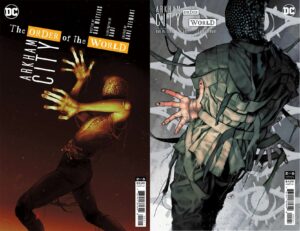 Arkham City: The Order of the World
Arkham City: The Order of the World Arkham City: The Order of the World
Arkham City: The Order of the World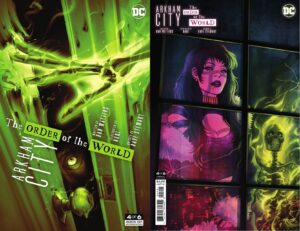 Arkham City: The Order of the World
Arkham City: The Order of the World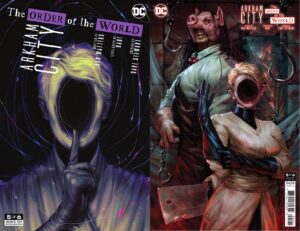 Arkham City: The Order of the World
Arkham City: The Order of the World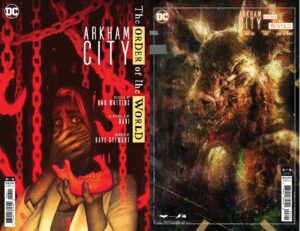 Arkham City: The Order of the World
Arkham City: The Order of the World Tales from the Dark Multiverse – Batman: Knightfall
Tales from the Dark Multiverse – Batman: Knightfall